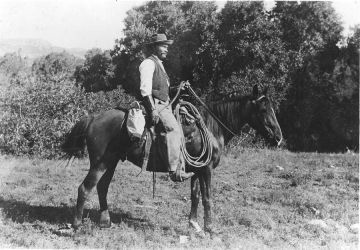by Amanda Mather, Curator of Collections

George McJunkin was born a slave in Midway, Texas. When he was about 10, the Civil War ended and he and his family were freed. He was born into a ranch and cowboy life and spent most of his life in the saddle. Mr. McJunkin worked at several ranches in Texas before finally settling in New Mexico.
The cowboys he grew up around taught him to read and write. As a young man he also taught himself to speak Spanish, play the guitar and violin. He loved history and archaeology and that love would play a pivotal role in Mr. McJunkin’s incredible find.
In 1908, the small New Mexico town of Folsom (near Raton) experienced a horrible flood that killed 18 of its citizens. After this terrible event, McJunkin was on horseback assessing the damage done to the fences and arroyos at the Thomas Owens Pitchfork Ranch where he worked. Upon entering an arroyo named Dead Horse, he noticed something odd. Huge rib bones were sticking out of the side of the arroyo and since George knew his archaeology, he knew they weren’t from any modern animal species.
McJunkin was correct; the bones were from a species called Bison antiquus, an animal that had died off with the mega fauna at the end of Ice Age, about 10,000 years ago. But even more striking amongst those ribs were projectile points, clearly put there by a group of humans.
He knew what he had just discovered. At the time of his incredible find, the archaeological establishment thought humans had only been on this continent for several thousands of years. Finding a point stuck in a bison that’s been gone for 10,000 years is proof that someone’s data is wrong.
McJunkin tried for years to get archaeologists to come see the site, to no avail. Finally, ten years later a man named Harold Cook from the Denver Museum of Natural History came to Folsom and did some exploratory digging with George. McJunkin had sent projectile points and some bone samples to Cook several years earlier.
Sadly, a full blown archaeological expedition was not launched at the Folsom site until after McJunkin’s passing in 1922. If it had not been for George’s passion for archaeology and keen eye, it may have taken much longer for us to discover that people had been on this continent for over 10,000 years.
Today, the type of point McJunkin found amongst those bison bones is called a Folsom Point, named for the little town of Folsom. It is the earliest type of projectile point found in both North and South America, and (if you ask me) one of the most striking. I have never found one personally, but always said if I ever do you’ll hear my holler from miles around.
In 2019, McJunkin was inducted into the Hall of Great Westerners at the National Cowboy and Western Heritage Museum in Oklahoma City. There are small exhibits dedicated to him at the Denver Museum of Natural History and the New Mexico History Museum. You can visit McJunkin’s grave at the Folsom Cemetery. The last time I went to visit him, there were fresh flowers on his grave, I gave him some more. I guess someone out there loves George as much as I do.
